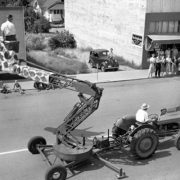A Brief History of Boom Lifts
Boom lifts, telescopic booms, cherry pickers, elevating work platforms; whatever you choose to call them, these marvellous machines are a fantastic solution to the problem of working at height in awkward-to-reach spaces.
Prior to the development of a platform or bucket on the end of a hydraulic arm, working at height almost always required the use of scaffolding or ladders. The problem with these, of course, is that there is little safety support for workers and they are problematic on uneven ground and in narrow spaces. Enter the boom lift, the king of access equipment.
Boom Lifts
Boom lifts are believed to have been invented by Canadian Walter E (Ted) Thornton-Trump in the 1950s. His affectionate name for this handy device was the Giraffe, but the name cherry picker stuck, thanks to their use in orchards.
Although they still serve their original purpose brilliantly, they are most often seen now in an urban context, particularly servicing overhead cables, telephone systems and street lights. Thornton-Trump finally patented his invention in the early ‘60s, describing his Giraffe as a “power-operated boom structure” and “lifting apparatus for electric-line and construction workers”.
By 1958, cherry pickers had also begun to be attached to fire engines in the US, and it was in this mobile format that they began to be imported and manufactured in Australia, becoming an increasingly common sight during the 1960s and ‘70s. Today, mobile boom lifts are usually referred to as ‘travel towers’.
Boom Lifts and Boom Lift Hire in Australia
In the early days of their use in Australia, elevated work platforms were almost exclusively mounted on trucks, but by the 1970s, a large number of stand-alone or mobile EWPs began to be used, often hired out with little or no training for the operator or guidance on maintenance.
By the 1980s, boom lifts were officially classified under the Crane Code, but safety standards and training advice was minimal. As a result, in 1987, concerned businesses formed the EWPAA (Elevating Work Platform Association of Australia) and this body pushed forward safety and training standards, including the Yellow Card certification of competency for operators of boom lifts. The Yellow Card is now the nationally recognised standard for operating EWPs.
Between May 2012 and May 2013, there were five serious accidents in New South Wales alone involving EWPs. At Force, we take access equipment hire seriously and work hard to ensure all our equipment is in excellent condition and operated by trained personnel. Our in-house trainers provide Yellow Cards for all scissor lifts & booms less than 11 metres. In fact, John Glover, Force’s National Service Manager, is the current president of the NSW Elevating Work Platforms Association.
Thanks to the EWPAA’s proactive self-regulation of the industry, industrial accidents involving boom lifts and cherry pickers have been reduced dramatically and now almost always involve inappropriate use of machinery, poor maintenance and a lack of training or safety harnesses. Don’t run the risk and use access equipment hired from a company you can trust.



